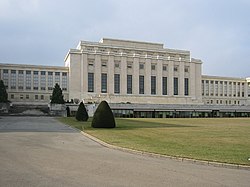
Back Volkebond Afrikaans Völkerbund ALS عصبة الأمم Arabic عصبة الامم ARZ জাতিসংঘ Assamese Sociedá de Naciones AST राष्ट्र संघ AWA Millətlər İttifaqı Azerbaijani میلّتلر لیقاسی AZB Liga Wangsa-Wangsa BAN
League of Nations Société des Nations (French) | |||||||
|---|---|---|---|---|---|---|---|
| 1920–1946 | |||||||
|
Semi-official flag (1939–41) | |||||||
 Headquarters of League of Nations at Geneva, Switzerland | |||||||
| Status | Intergovernmental organisation | ||||||
| Capital | Geneva, Switzerland[a] | ||||||
| Administrative center | Geneva, Switzerland | ||||||
| Common languages | French and English | ||||||
| Secretary‑General | |||||||
• 1920–33 | Sir Eric Drummond | ||||||
• 1933–40 | Joseph Avenol | ||||||
• 1940–46 | Seán Lester | ||||||
| Deputy Secretary-General | |||||||
• 1919–23 | Jean Monnet | ||||||
• 1923–33 | Joseph Avenol | ||||||
• 1937–40 | Seán Lester | ||||||
| Historical era | Interwar period | ||||||
| 10 January 1920 | |||||||
• First meeting | 16 January 1920 | ||||||
| 20 April 1946 | |||||||
| |||||||
| |||||||
The League of Nations (French: Société des Nations) was the predecessor to the United Nations. The League was founded in 1920, after World War I, but failed to maintain peace and prevent World War II. The League had a Council of the great powers and an Assembly of all of its member countries.
The League of Nations was thought up by US President Woodrow Wilson during World War I. It was to be a group of nations that worked together to keep peace. One of the reasons for its downfall was that, after a vote, the US Senate refused to join.
The League did not have the power to enforce any of its rules. That later proved to be a fatal flaw in the League's structure.
Another flaw in the League was that it was not representative enough. It never had more than 65 members, and the interests of the great powers often outweighed those of weaker members.
The League also had no troops of its own, and the decisions that it made were often slow. For example, when the Empire of Japan invaded Manchuria (North-eastern China) in 1931, the League took a whole year to decide to tell Japan to leave. Instead, Japan left the League. When Italy invaded Abyssinia in 1935, the League condemned it more quickly. Italy simply left the League and finished its conquest. After these disasters, the League was thought to be weak and powerless and stopped operations in 1939.
The League did not fail completely since it had prevented a few conflicts in Europe in the 1920s and worked hard to relieve various public health and social problems around the world.
In 1946, the inactive League of Nations formally ended and was replaced by the United Nations, which still does many of the same things that the League of Nations did.
